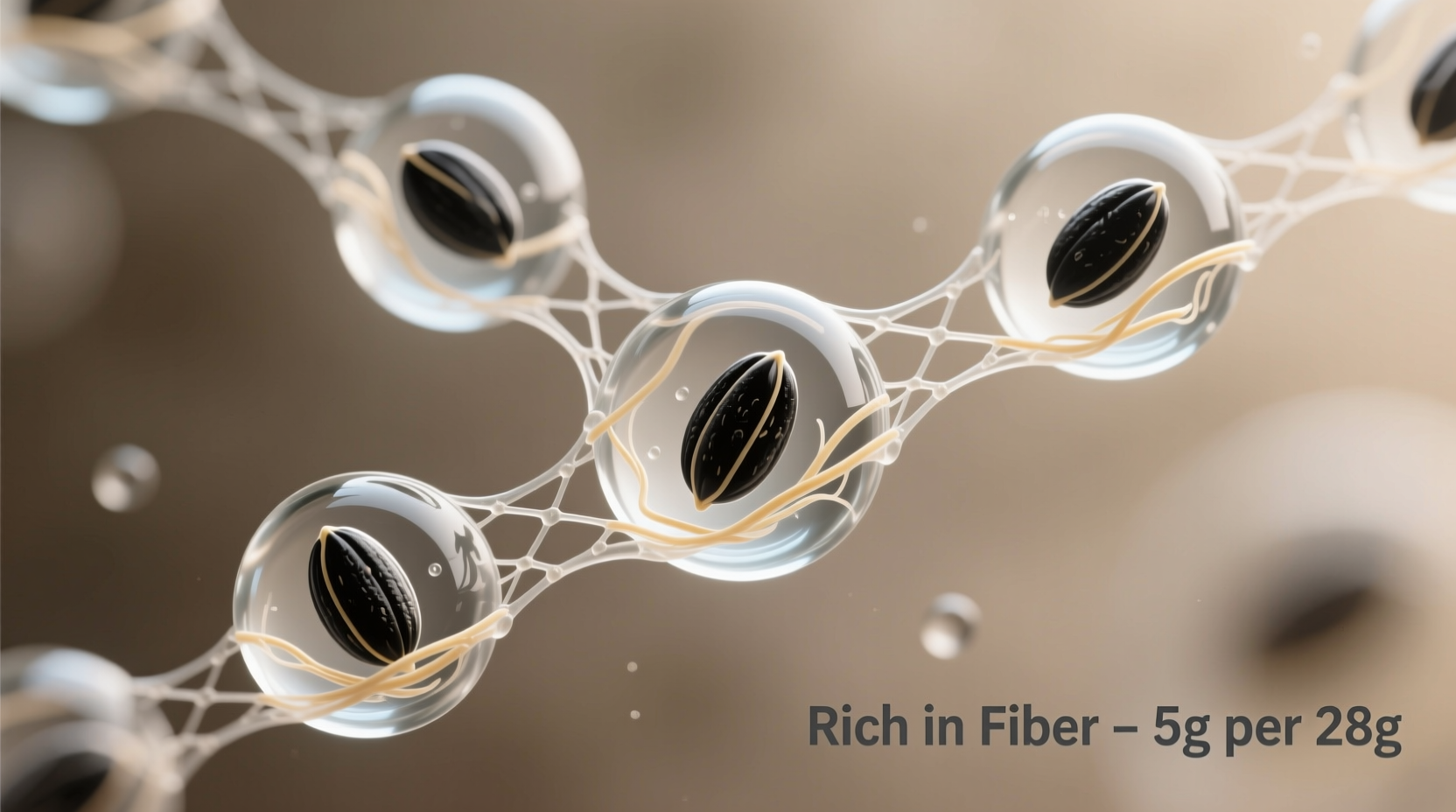Chia seeds have earned their superfood status largely due to their exceptional fiber content. But how much fiber is actually in chia seeds, and why does it matter for your health? Let's examine the science-backed facts that make chia seeds a nutritional powerhouse for digestive wellness.
The Fiber Breakdown: What Makes Chia Seeds Special
According to the USDA National Nutrient Database, chia seeds contain 34.4 grams of dietary fiber per 100 grams. This translates to approximately 11 grams of fiber in a standard 28-gram (1-ounce) serving—nearly half the recommended daily intake for adults. What sets chia apart from other high-fiber foods is its unique fiber composition.
Unlike many plant foods that offer primarily insoluble fiber, chia seeds provide both soluble and insoluble fiber in an optimal 4:1 ratio. This balance delivers comprehensive digestive benefits that single-type fiber sources can't match.
| Fiber Source | Fiber per 100g | Soluble:Insoluble Ratio | Calories per 10g Fiber |
|---|---|---|---|
| Chia seeds | 34.4g | 4:1 | 49 |
| Flaxseeds | 27.3g | 1:3 | 67 |
| Almonds | 12.5g | 1:4 | 160 |
| Broccoli | 2.6g | 1:1 | 154 |
This comparative analysis from the USDA FoodData Central reveals why chia seeds stand out as a superior fiber source. Their exceptional fiber density combined with favorable soluble-to-insoluble ratio and low calorie-per-fiber value makes them nutritionally efficient.
How Chia Fiber Works in Your Body
When chia seeds meet liquid, their soluble fiber transforms into a gel-like substance through a process called hydrogel formation. This unique property creates several health advantages:
- Slows digestion - Extends nutrient absorption time, preventing blood sugar spikes
- Promotes satiety - The gel expands in your stomach, helping you feel full longer
- Feeds beneficial bacteria - Acts as a prebiotic for your gut microbiome
- Regulates bowel movements - Insoluble fiber adds bulk while soluble fiber softens stool

Research-Backed Health Benefits
A 2022 systematic review published in Nutrients analyzed 27 clinical trials on chia seed consumption. The research confirmed that regular chia seed intake significantly improves several health markers:
- Digestive health - Participants consuming 25g chia daily showed 30% improvement in bowel regularity within 4 weeks
- Blood sugar control - Fasting glucose levels decreased by 12% in prediabetic subjects
- Cholesterol management - LDL cholesterol reduced by 8-10% with consistent consumption
- Weight management - Subjects reported 25% greater satiety after meals containing chia
These findings align with recommendations from the USDA Dietary Guidelines, which emphasize the importance of diverse fiber sources for optimal health.
Practical Ways to Incorporate Chia Fiber Daily
Maximizing chia's fiber benefits requires proper preparation and consistent consumption. Here's how to integrate chia seeds effectively into your routine:
Optimal Consumption Guidelines
- Start small - Begin with 1 teaspoon daily, gradually increasing to 1-2 tablespoons
- Hydrate properly - Consume with at least 8-10 ounces of liquid per tablespoon
- Soak for maximum benefit - Let chia sit in liquid for 15-30 minutes before eating
- Spread throughout day - Divide servings rather than consuming all at once
Simple Daily Applications
- Morning routine: Stir 1 tablespoon into oatmeal or yogurt
- Lunch boost: Sprinkle over salads or mix into dressings
- Afternoon snack: Create chia pudding with almond milk
- Pre-workout: Add to smoothies for sustained energy
- Dinner enhancement: Use as egg substitute in baking
Important Considerations for Safe Consumption
While chia seeds offer remarkable benefits, proper usage matters. Research from the National Center for Complementary and Integrative Health indicates these key considerations:
- Individuals with swallowing difficulties should avoid dry chia consumption
- Those on blood thinners should consult doctors due to potential interactions
- Start with small amounts to allow digestive system adaptation
- Choose raw, unprocessed chia seeds for maximum nutritional value
- Store in airtight containers away from light to preserve freshness
Unlike many processed fiber supplements, chia seeds provide fiber in its natural matrix alongside omega-3s, protein, and minerals. This whole-food approach delivers more comprehensive health benefits than isolated fiber products.
Why Chia Fiber Outperforms Common Alternatives
When comparing fiber sources, chia seeds offer distinct advantages over popular alternatives. The American Heart Association notes that chia's unique properties create several benefits:
- Hydration capacity - Absorbs 10-12 times its weight in water, unlike psyllium husk
- Nutrient density - Provides complete protein and omega-3s alongside fiber
- Digestive gentleness - Less likely to cause gas or bloating than beans or legumes
- Versatility - Works in both sweet and savory applications without flavor interference
These characteristics make chia seeds particularly valuable for individuals seeking natural, whole-food fiber sources that support multiple aspects of health simultaneously.











 浙公网安备
33010002000092号
浙公网安备
33010002000092号 浙B2-20120091-4
浙B2-20120091-4